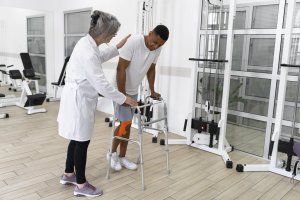Catastrophic injuries are life-altering events that involve severe trauma, such as spinal cord injuries, traumatic brain injuries (TBI), and multiple fractures. These injuries can drastically affect a person’s ability to move, work, and perform daily tasks, often leading to long-term medical care and rehabilitation. Rehabilitation plays a critical role in helping patients regain mobility, independence, and improve their overall quality of life after such devastating injuries.
At Pittsburgh Injury Lawyers, P.C., we are dedicated to helping victims of catastrophic injuries secure the compensation they need to access the best rehabilitation technologies and medical care. As leading Pittsburgh injury lawyers, we advocate for our clients, ensuring they have the resources necessary to rebuild their lives and achieve the highest possible recovery.
Overview of Rehabilitation Technologies
Technological advancements are transforming the way rehabilitation is conducted, particularly for catastrophic injury patients. These cutting-edge tools and devices are designed to enhance mobility, reduce pain, and accelerate the recovery process. For individuals with severe injuries, these innovations can mean the difference between dependency and independence.
Advanced rehabilitation technologies allow medical professionals to create more personalized, effective treatment plans. By leveraging the latest tools, physical therapists, occupational therapists, and doctors can tailor rehabilitation programs to address the specific challenges each patient faces, providing them with the best chance for recovery.
Each catastrophic injury is unique, and no two patients have the same recovery needs. Technologies like robotics-assisted therapy and wearable sensors enable therapists to design personalized programs that focus on the patient’s individual strengths, limitations, and goals. Through collaboration with medical professionals and the use of advanced equipment, these customized plans help patients achieve the best outcomes, whether that’s regaining the ability to walk or improving motor skills lost due to a brain injury.
Key Rehabilitation Technologies for Catastrophic Injury Patients
Robotics-Assisted Therapy
Robotics-assisted therapy has revolutionized rehabilitation for patients with limited mobility, particularly those with spinal cord injuries or neurological conditions. Devices like exoskeletons (e.g., Ekso Bionics) allow patients with lower body paralysis to stand, walk, and relearn motor functions. These robotic devices support the patient’s body and provide assistance in movement, helping them regain strength and coordination.
For patients who may never walk independently again, robotics-assisted therapy offers a way to restore some level of mobility, reducing their reliance on wheelchairs or caregivers.
Virtual Reality (VR) in Therapy
Virtual reality (VR) is another innovative tool in rehabilitation, particularly for patients recovering from traumatic brain injuries. VR immerses patients in simulated environments where they can practice real-world tasks in a controlled, safe setting. This technology not only improves cognitive functions but also enhances physical abilities by encouraging patients to engage in interactive exercises.
The use of VR helps patients rebuild skills like balance, coordination, and problem-solving, making it a valuable resource for those recovering from brain injuries and other neurological conditions.
Functional Electrical Stimulation (FES)
Functional Electrical Stimulation (FES) uses electrical currents to stimulate nerves in paralyzed muscles, promoting movement and preventing muscle atrophy. This technology is particularly effective for patients with spinal cord injuries or strokes, allowing them to perform daily tasks like grasping objects or walking. By reactivating paralyzed muscles, FES helps patients regain control over their bodies and enhances their overall independence.
Wearable Sensors and Smart Technology
Wearable sensors are becoming an essential tool in rehabilitation, as they allow therapists to monitor a patient’s movements in real time. These devices provide feedback that can be used to adjust exercises and track progress throughout the rehabilitation process. For amputees, smart prosthetics that adapt to the user’s movements are another breakthrough, offering more natural limb function and improving their ability to walk, grasp, or perform other tasks.
Tele-rehabilitation and Remote Monitoring
Tele-rehabilitation has grown in popularity, allowing patients to access therapy remotely through digital platforms. This technology is particularly beneficial for those who live far from rehabilitation centers or have difficulty traveling. Remote monitoring tools, combined with tele-rehabilitation, enable continuous assessment of a patient’s progress, ensuring they stay on track with their recovery even outside of traditional clinical settings.
Benefits and Challenges of Using Advanced Technologies in Rehabilitation
Advanced rehabilitation technologies offer numerous benefits for patients with catastrophic injuries. These tools have been shown to improve outcomes, enabling patients to achieve greater mobility, faster recovery, and increased independence. For some, these technologies can reduce the need for invasive surgeries or long-term dependence on caregivers, significantly improving their quality of life.
Despite the benefits, access to advanced rehabilitation technologies comes with challenges. Many of these tools are expensive, and not all patients can afford them. Insurance coverage may be limited, and some patients may struggle to secure the financial support they need to access cutting-edge treatments. This is where legal support becomes crucial. A Pittsburgh injury lawyer can help patients seek compensation to cover these costs, ensuring they have access to the best rehabilitation resources available.
Conclusion
The future of rehabilitation for catastrophic injuries is bright, with advanced technologies continuing to transform the way patients recover. These innovations offer new hope to those facing severe injuries, enabling them to regain mobility, independence, and a higher quality of life.
At Pittsburgh Injury Lawyers, P.C., we are committed to advocating for catastrophic injury victims, ensuring they have access to the medical care and rehabilitation technologies they need. As dedicated Pittsburgh injury lawyers, we work tirelessly to help our clients secure the compensation necessary to afford the most advanced treatments and achieve the best possible recovery.

